Known for its stunning system of rings, Saturn is truly a gem of the solar system. Although Jupiter, Uranus, and Neptune also have rings, only Saturn’s are easily visible from Earth and are an icon of astronomy. Yet these rings were unknown until the 1600s. For the first five and a half millennia, Saturn was simply the slowest of the five “wandering stars.” The invention of the telescope in 1608 paved the way for more advanced telescopes, eventually allowing astronomers to see Saturn in all its splendor.
Orbital Properties and Physical Characteristics
Saturn orbits the sun at an average distance of 890 million miles, which is nine and a half times the radius of Earth’s orbit. The sun would therefore appear nearly ten times smaller as seen from Saturn, and would be 92 times fainter. With so little solar energy, Saturn maintains a rather chilly temperature of 218 degrees below zero on the Fahrenheit scale.[1] Saturn takes 29.5 years to orbit the sun once. But it has the second fastest rotation of any planet: about 10.5 hours.
Saturn is a Jovian planet – meaning “like Jupiter.” It is a gas giant, with no solid surface, consisting almost entirely of hydrogen and helium gas with trace elements that form compounds like ammonia and methane. These trace compounds give rise to the subtle colors in the atmosphere of Saturn. Saturn’s clouds are stretched into belts and zones, much like on Jupiter. But Saturn’s belts and zones are far less distinctive in appearance than those of Jupiter. Saturn’s rapid rotation causes the shape of the planet to be an oblate spheroid, with an equatorial radius that is noticeably larger than its polar radius – just like Jupiter.
Saturn is about nine Earths in diameter, just a bit smaller than Jupiter, though considerably less massive. Saturn has the lowest density of any planet in the solar system. The average density of Saturn is only 0.687 grams per cubic centimeter, which is less than that of water. Hence, unlike any other planet, Saturn would float in water.
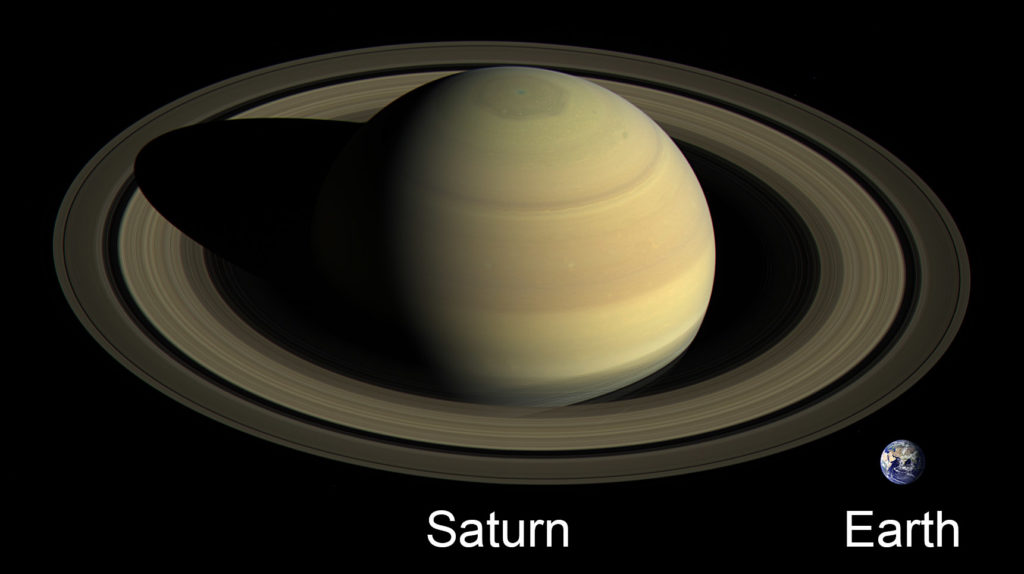
Saturn’s rotation axis is tilted nearly 27 degrees relative to its orbital axis, a bit more than Earth’s 23.5-degree tilt. Hence, Saturn experiences seasons like Earth, but nearly 30 times longer due to Saturn’s lengthy orbital period. Such a tilt is problematic from a secular perspective. In the standard secular formation scenario, the planets are said to have formed from a collapsing proto-solar nebula. In such a case, they all should be spinning about the same axis as their orbit due to conservation of angular momentum. But many do not. The Earth’s axial tilt is sometimes explained as the result of a large impact (for which there is no evidence). But this explanation won’t work for a large gas giant like Saturn. Instead, its tilt is a design feature, as we will explore below.
Saturn often develops storms in its atmosphere, which appear as either black or white features. It lacks a permanent storm like Jupiter’s Great Red Spot. However, a large white storm often appears in Saturn’s northern hemisphere during (Saturn’s) summer, which happens every thirty years. This storm was seen in 1990 and the next one was expected to appear in 2020. However, an enormous white storm appeared in 2010 – ten years early, much to the delight of astronomers. Fortunately, the Cassini spacecraft was orbiting Saturn at that time, and provided spectacular images of the event.

February 25, 2011
Like Jupiter, Saturn possesses significant internal heat. It radiates over 2.5 times as much energy as it receives from the sun. Since Saturn lacks any substantial radioactive elements to produce such heat, the most plausible explanation is that such heat is primordial – that is, God initially created Saturn with internal heat. But, if Saturn were billions of years old as secularists claim, then it should have radiated away all its heat long ago. Internal heat is generally indicative of recent creation.
Likewise, Saturn has a powerful magnetic field, though not as powerful as Jupiter’s field. Magnetic fields are caused by the movement of charged particles – electrical current. Since such current naturally decays over time, Saturn’s magnetic field is an indication that the planet is only thousands of years old, and nowhere near the secular assumed age. Saturn’s magnetic field often produces aurora near its poles.
Four spacecraft have visited Saturn. Pioneer 11 was the first to fly by Saturn in September, 1979. Voyager 1 visited Saturn in 1980, providing high-resolution images of the planet, its rings, and some of its moons. In particular, it made a close pass to Saturn’s largest moon: Titan. Voyager 2 passed Saturn in 1981, confirming the discovery of several new moons. The Cassini spacecraft was placed into orbit around Saturn in 2004, producing high-resolution images and collecting other data until the end of its mission in 2017.
Lord of the Rings
The most iconic feature of Saturn belongs not to the planet itself, but its system of rings. Galileo observed Saturn in his homemade telescope in the year 1610. He could see that Saturn appeared abnormally shaped. It was not a simple sphere, but had noticeable features on its left and right sides. However, his telescope was insufficient to discern what these features were. He thought perhaps he was seeing two moons to the left and right of Saturn. But why did they fail to orbit Saturn? The nature of Saturn’s odd appearance was perhaps the central problem in astronomy in the early to mid-1600s. The solution came in 1655, when Christiaan Huygens was able to discern that Saturn was encircled by a flat disk of rings.
Initially, most astronomers believed that the rings were a single solid disk. But we now understand that Saturn’s rings are composed of trillions of tiny moonlets made mostly of water ice that orbit around Saturn’s equator. These range in size from particles of dust, to larger pebbles, and perhaps some accretions that are several feet across. The main (easily visible) rings extend from 4,300 miles to 50,000 miles away from Saturn’s equator. For comparison, the (equatorial) radius of Saturn is 37,500 miles. The rings orbit in the plane of Saturn’s equator, and are less than one mile thick. For this reason, they cannot be seen when viewed edge-on.
The main rings are divided into three visibly distinct systems, called the A, B, and C rings. The A ring is the outermost, and is physically separated from the B ring by a noticeable break called the Cassini division. The Cassini division is often visible in a moderate backyard telescope under good seeing conditions. This thin break is, in reality, 2,920 miles wide! Although not completely empty, the Cassini division has far fewer particles than the main rings, and therefore appears dark.
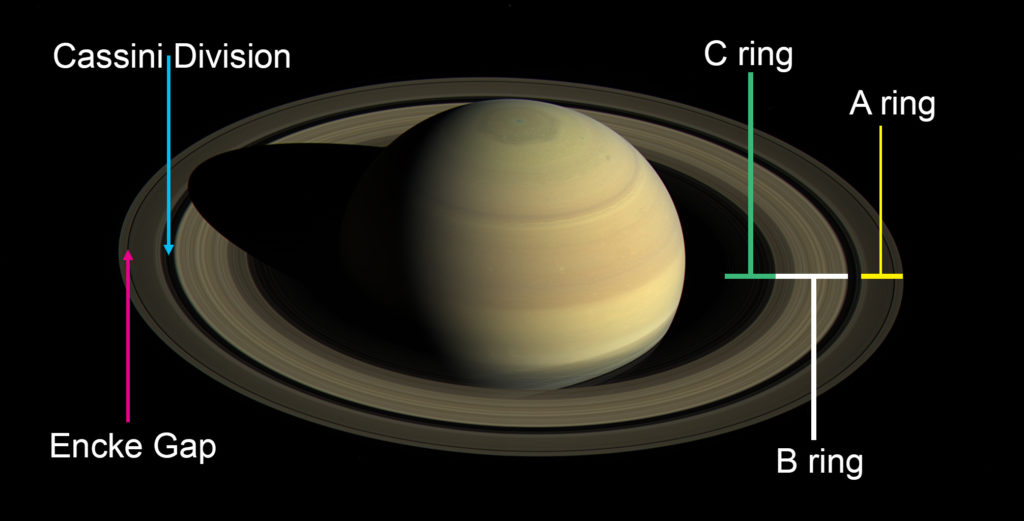
The B ring is the brightest, and along with the A ring is easily visible in even a modest backyard telescope. In the 1980s, images from the Voyager missions revealed the existence of “spokes” within the B ring. These appeared as radial lines extending away from Saturn like the spokes of a bicycle wheel. Strangely, these spokes even appeared to exhibit solid-body rotation. That is, they do not move with the particles (which rotate differentially in accordance with Kepler’s third law), but all rotate with the same angular velocity as if they were on a solid disk. There are several hypotheses to explain these spokes, but there is currently no consensus explanation.

The inner C ring is the faintest of the three, but can still be detected with high-quality Earth-based telescopes. These three ring systems have a much finer structure within them, consisting of hundreds of thin rings within each. And there are several small breaks within these systems, similar to the Cassini division, but narrower. Most well-known of these is the Encke gap within the A system.[2] It is possible, though very challenging, to see the Encke gap in a high-quality backyard telescope under ideal conditions.
Another very faint ring system was discovered in 1966. Now referred to as the E ring, it is actually a torus of material rather than a flat, thin disk. It is over twice the distance from Saturn’s atmosphere as the A ring. The Cassini spacecraft found that the E ring is comprised of material ejected in geysers from Saturn’s moon Enceladus.
The four unmanned spacecraft that have visited Saturn have vastly improved our knowledge of the rings, since they have imaged features that are not easily detected from Earth. Voyager 1 discovered the D ring, a very faint system that lies inside the C ring and extends very nearly to the outer atmosphere of Saturn. Pioneer 11 discovered the F ring. Unlike the other rings which appear as broad sheets, the F ring consists of a single primary strand and a secondary thread that appears to twist around the primary. The F ring lies just outside the A ring; the two are separated by the Roche division. A faint G ring has also been discovered lying between the F and E rings. All these rings orbit in the plane of Saturn’s equator, and their particles revolve around Saturn prograde – in the same direction Saturn rotates.

More recently, astronomers have found evidence of an extremely faint but enormous ring at a much greater distance from Saturn. This Phoebe ring extends from about 3.8 million miles to 10.1 million miles away from Saturn, and encompasses the orbit of Saturn’s moon Phoebe. The ring lies in the plane of Saturn’s orbit – not Saturn’s equator, and consequently is tilted relative to all the other rings by 27 degrees. The Phoebe ring orbits retrograde – the opposite direction of Saturn’s rotation, as does the moon Phoebe. This enormous ring is thought to have been produced by material ejected from Phoebe.
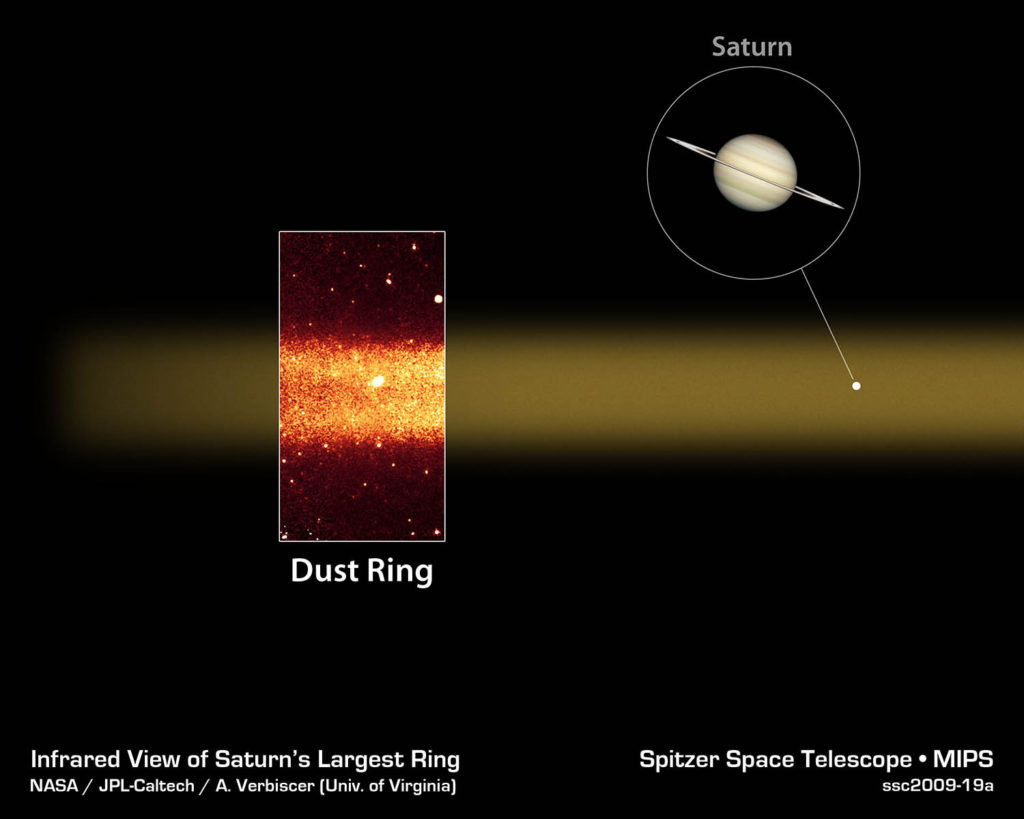
Saturn’s rings are a transient phenomenon. They will not last forever. In fact, they cannot last billions of years. This is because a number of processes cause the particles in the rings to erode or spiral inward over time. Collisions between the particles results in a net loss of orbital energy. The very smallest particles are subject to radiation pressure, which can degrade their orbit. Gravitational perturbations caused by Saturn and its moons will affect the orbits of the particles in the rings. And the magnetic field of Saturn will produce a force on any charged particles. Most secularists now agree that rings cannot last billions of years. They therefore think that such rings are a recent formation in a very old solar system. But what is the probability that we would be so fortunate as to live at a time when all four of the large planets have recently developed rings?

Observing Saturn
When people have the opportunity to see Saturn for the first time in a backyard telescope, the reaction is almost always the same: “Wow!” It won’t look as big or as sharply focused as the wonderful Hubble or other spacecraft images we see in textbooks. Nonetheless, there is something magical about the inimitable experience of seeing this little gem with your own eyes. The rings give Saturn a unique 3-dimensional appearance unrivaled in beauty. Yet, this seemingly little jewel is far larger than Earth and only appears tiny because we are seeing it from nearly a billion miles away. But what details can you expect to see on Saturn?
Saturn’s appearance in a telescope varies dramatically depending on where Saturn is in its 29.5-year orbit. It appears to observers on Earth as if Saturn’s tilt gradually changes from a maximum of 27 degrees, to zero degrees, to -27 degrees, back to zero degrees and then finally back to 27 degrees. The complete cycle lasts 29.5 years – the same as Saturn’s orbital period around the sun. In reality, Saturn’s equator is always tilted 27 degrees relative to its orbital plane. But, as Saturn orbits the sun, the inner planets observe Saturn from different perspectives. Consequently, twice every Saturn orbit, we see Saturn edge-on. This happens roughly every 15 years, when Saturn experiences its fall or spring equinox.
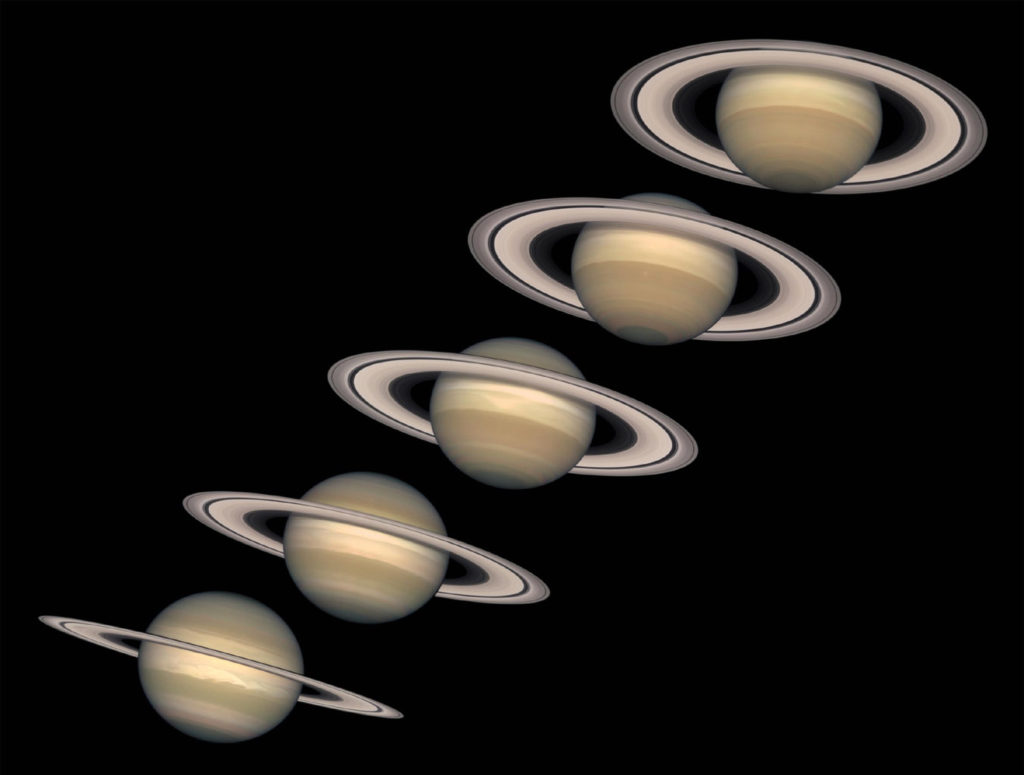
In the weeks surrounding the moment when Saturn is exactly edge-on from our perspective, the rings cannot be seen at all due to their thin vertical extent. This gives Saturn a very unusual, “ringless” appearance. In the months before or after this moment, when the rings are tilted only slightly from our perspective, they appear as a thin line segment sticking through Saturn. On the other hand, when Saturn passes its summer or winter solstice, we see Saturn and its rings at their maximum tilt of nearly 27 degrees, and Saturn looks really spectacular. The last maximum apparent tilt occurred in 2017. Note that if God had not tilted Saturn’s rotation axis relative to its orbit, Saturn would always appear edge-on from Earth and we would never see those glorious rings.
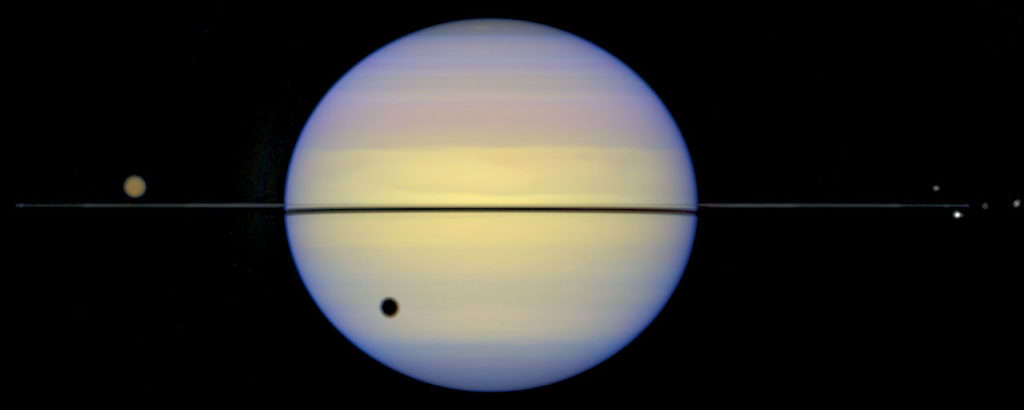
The gradual change of Saturn’s apparent tilt is complicated by the fact that Earth also orbits the sun. And the plane of Earth’s orbit is not exactly the same as the plane as Saturn’s orbit – though they are very similar. Consequently, Earth is sometimes just above the plane of Saturn’s orbit, and sometimes just below this plane. The Earth of course crosses this plane twice every year. Likewise, the Earth is sometimes a bit closer to Saturn, and at other times a bit farther when the two planets are on opposite sides of the sun. Hence, a time-lapse animation of Saturn as seen from Earth shows a rapid (one year) wobble due to Earth’s orbit, combined with a slower gradual change of apparent tilt due to Saturn’s orbit around the sun over the course of 29.5 years.
This combination can lead to some interesting effects around the time Saturn appears edge-on. In some cases, Saturn can appear to be edge-on three times in a row over the course of several months. This happens when Saturn reaches an equinox at about the same time that Earth crosses the plane of Saturn’s orbit from the same direction. This situation occurred in the mid-1990s when Saturn appeared edge-on in May 1995, in August 1995, and again in February 1996. In other cases, Saturn merely appears edge-on once during its equinox crossing, as it did in September 2009. The next edge-on appearance will be a single event in March 2025. However, the 2038-2039 crossing will be a triple (July 2038, October 2038, and April 2039). Saturn’s rings can also seem to be invisible when the planet is edge-on relative to the sun, but not relative to Earth. In such a case, the rings are not illuminated except on their thin leading edge.
Aside from the enjoyment of seeing a rare ringless Saturn, the edge-on events of Saturn do have another advantage. They are the best time to attempt to observe Saturn’s fainter, inner moons. Saturn has 82 known moons. The inner 23 moons orbit approximately in the same plane as Saturn’s rings, and relatively close to Saturn.[3] Several of these moons orbit just outside the main ring system. The brightness of Saturn’s rings can make it difficult, though not impossible, to detect these faint moons in a backyard telescope. But when Saturn appears edge-on, the rings disappear and the moons stand out. Furthermore, at such a time, these inner moons all appear in a straight line since their orbital plane appears edge-on. This makes them even easier to detect. So take advantage of the next edge-on appearance of Saturn in March 2025.
However, Saturn is most glorious when it appears maximally tilted from our perspective: either positive 27 degrees so that we see Saturn’s north pole, or negative 27 degrees when we can see the south pole. At such times, even the far side of Saturn’s rings can be seen extending just above or below the pole from our perspective. At times of maximum tilt, the internal structure of the rings is most easily visible. A backyard telescope will often reveal the Cassini division, as well as the noticeable brightness difference between the A and B rings. You can often see the shadow that the rings cast on the planet, or the shadow that the planet casts on the far side of the rings.[4]
Regardless of where Saturn is in its orbit, the planet is best viewed when at opposition – when the Earth is most directly between Saturn and the sun. This happens roughly once per year.[5] During this time, the Earth is closest to Saturn, and so the planet appears slightly larger and brighter than it does months before or after the event. This is also true for the other planets. But with Saturn, we get another bonus on the night of opposition. At that time, sunlight scatters directly back from Saturn’s rings, and they appear noticeably brighter than they do at any other time. This is called the Seeliger effect. The effect lasts only for a few days surrounding opposition.
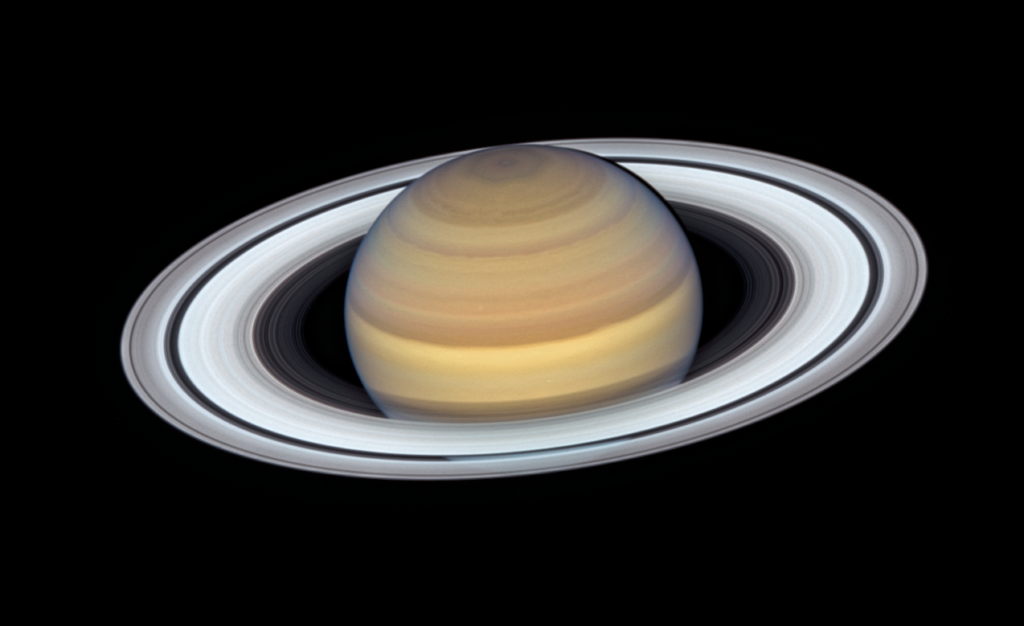
If you ever have the opportunity to observe Saturn through a telescope, I highly recommend you take it. It’s quite an experience. But we are so blessed to live in a time when advances in technology have allowed superb Earth-based and space-based images of Saturn that are available to all. Who knows what other treasures the Lord has placed in His creation for us to discover? Much more to come.
[1] This is the estimated temperature at a depth corresponding to 1 bar of atmospheric pressure.
[2] Breaks between systems of rings are called divisions. The Cassini division is a break between the A and B system. Breaks within a system of rings is called a gap. Hence, the Encke gap is within the A ring system. This nomenclature is rather modern, and older literature will sometimes refer to the Encke division.
[3] Typically, you can see one to six of Saturn’s moons in a backyard telescope, depending on your skill, the quality of the instrument, and the darkness of the sky. However, more can often be seen when the rings appear edge-on.
[4] The shadow of the planet on the rings is most easily seen when Saturn is several months before or after opposition.
[5] Saturn appears at opposition every 378 days on average.

